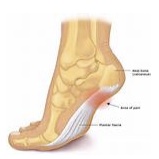Plantar Fascia – Foot Pain
(wikipedia)
Plantar fasciitis (PF) is a painful inflammatory process of the plantar fascia, the connective tissue on the sole (bottom surface) of the foot. It is often caused by overuse of the plantar fascia or arch tendon of the foot. It is a very common condition and can be difficult to treat if not looked after properly. Another common term for the affliction is “policeman’s heel”.[1]
Longstanding cases of plantar fasciitis often demonstrate more degenerative changes than inflammatory changes, in which case they are termed plantar fasciosis.[2] The suffix “osis” implies a pathology of chronic degeneration without inflammation. Since tendons and ligaments do not contain blood vessels, they do not actually become inflamed. Instead, injury to the tendon is usually the result of an accumulation over time of microscopic tears at the cellular level.
The plantar fascia is a thick fibrous band of connective tissue originating on the bottom surface of the calcaneus (heel bone) and extending along the sole of the foot towards the toes. It has been reported that plantar fasciitis occurs in two million Americans a year and in 10% of the U.S. population over a lifetime.[3] It is commonly associated with long periods of weight bearing. Among non-athletic populations, it is associated with a high body mass index.[4] The pain is usually felt on the underside of the heel and is often most intense with the first steps of the day. Another symptom is that the sufferer has difficulty bending the foot so that the toes are brought toward the shin (decreased dorsiflexion of the ankle). A symptom commonly recognized among sufferers of plantar fasciitis is an increased probability of knee pains, especially among runners.
Causes & Treatment
Most lower extremity injuries are caused by overuse, and typically occur with a change in shoes, surface, or intensity. Examples would be increasing speed or mileage too quickly for a runner, changing types, styles, or shoe companies, and changing from a treadmill to outdoor surfaces. These variables can all alter biomechanics of the knee and ankle joints. Growth spurts while athletes are maturing, can also alter the mechanics enough to cause one of the above conditions. Athletes transitioning too quickly to barefoot or minimalist shoes, can also easily instigate an episode of plantar fasciaitis, due to the increase of flexibility required to run without a raised heel running shoe.
Our office treats plantar fascia with a combination of Active Release Techniques, Graston techniques, and sport taping to reinforce the anatomy, this combined with stretching, cryokinetics, and ultimately strength and stabilization of the surrounding anatomy get us results where others fail.
Related Articles:

